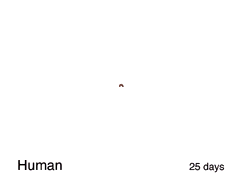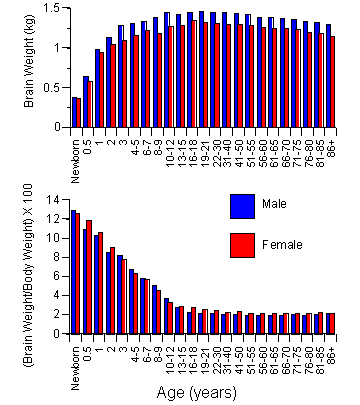
|

|
|
|
Human Brain Development
(images thanks to Univ. of Utah Medical School site)
While the fetus brains and adult brains may initially look very similar, in fact, an infant experiences significant brain development as he/she grows.
For example, the movie below demonstrates the growth of a fetus' brain, from 25 days to 9 months.
 A newborn infant has approximately the same number of neurons as an adult, yet only about 25% of the brain volume has developed. In addition, neural connections are not fully formed either. In fact, during the first month of life, the number of connections ("synapses") dramatically increases from approximately 50 trillion to upwards of 9000 trillion. If an infant's body grew at a comparable rate, it's weight would increase from 8.5 pounds at birth to 170 pounds at one month old. For another dramatic example of how the brain changes during development, look at the figure below:
 (graphs thanks to Dr. Chudler's site) This chart shows us that the brain grows tremendously during the first few years of life and then levels off. Note also that these years of tremendous growth are also accompanied by tremendous changes in behavior! Another interesting study made measurements of brain activity showing that during the second half of a child's first year, the prefrontal cortex, the seat of forethought and logic, forms synapses at such a rate that it consumes twice as much energy as an adult brain. That intense pace continues for the child's first decade of life.

 Is infancy the only time that such changes take place in the human brain? Is infancy the only time that such changes take place in the human brain?
HOME || VARIATION || PATHOLOGY || GENDER & SEXUAL ORIENTATION || BIBLIOGRAPHY
|